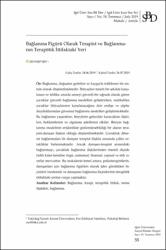| dc.contributor.author | Set, Zeynep | |
| dc.date.accessioned | 2022-05-11T14:32:19Z | |
| dc.date.available | 2022-05-11T14:32:19Z | |
| dc.date.issued | 2019 | |
| dc.identifier.issn | 2147-6152 | |
| dc.identifier.uri | https://app.trdizin.gov.tr/makale/TXpjd01qZ3hNUT09 | |
| dc.identifier.uri | https://hdl.handle.net/20.500.11776/7458 | |
| dc.description.abstract | Bağlanma, doğuştan getirilen ve kaygıyla tetiklenen bir sistem olarak düşünülmektedir. İhtiyaçları tutarlı bir şekilde karşılanan ve tehlike anında anneyi güvenli bir sığınak olarak görençocuklar güvenli bağlanma modelleri geliştirirken, reddedilençocuklar ihtiyaçlarının karşılanacağına dair endişe ve şüpheduyduklarından güvensiz bağlanma modelleri geliştirmektedir.Bu bağlanma yaşantıları, bireylerin gelecekte kuracakları ilişkileri, beklentilerini ve algılama şekillerini etkiler. Bireyin bağlanma modelinin erişkinlikte gözlemlenebildiği bir alanın terapist-danışan ilişkisi olduğu düşünülmektedir. Çocukluk dönemi bağlanmaları ile danışan terapist ilişkisi arasında çoklu ortaklıklar bulunmaktadır. Ancak danışan-terapist arasındakibağlanmayı, çocukluk bağlanma ilişkilerinden önemli ölçüdefarklı kılan kendine özgü, zamansal, finansal, yapısal ve etik sınırlar mevcuttur. Bu makalenin temel amacı, psikoterapistlerin,danışanları için bağlanma figürleri olarak işlev gördükleri biçimleri incelemek ve danışanın bağlanma biçimlerinin terapötikittifaktaki yerine vurgu yapmaktır. | en_US |
| dc.description.abstract | Attachment is thought to be an innate and anxiously triggered system. Children whose needs are consistently met and who see the mother as a haven in the event of danger develop secure attachment patterns, while rejected children develop insecure attachment because they are concerned and doubted that their needs will be met. These attachment experiences affect the future relationships, expectations, and perceptions of individuals. One area where the attachment model of the individual can be observed in adulthood is thought to be the therapist-client relationship. There are multiple commonalities between childhood attachment and the client-therapist relationship. However, there are specific, temporal, financial, structural and ethical boundaries that differentiate client-therapist attachment from childhood attachment. The main purpose of this article is to examine how psychotherapists function as attachment figures for their clients and to emphasize the role of the client's attachment styles in the therapeutic alliance | en_US |
| dc.language.iso | tur | en_US |
| dc.rights | info:eu-repo/semantics/openAccess | en_US |
| dc.title | Bağlanma Figürü Olarak Terapist ve Bağlanmanın Terapötik İttifaktaki Yeri | en_US |
| dc.title.alternative | TheTherapist as Attachment Figure and the Role of Attachment in the Therapeutic Alliance | en_US |
| dc.type | article | en_US |
| dc.relation.ispartof | Iğdır Üniversitesi Sosyal Bilimler Dergisi | en_US |
| dc.department | Fakülteler, Fen Edebiyat Fakültesi, Psikoloji Bölümü | en_US |
| dc.identifier.volume | 0 | en_US |
| dc.identifier.issue | 19 | en_US |
| dc.identifier.startpage | 55 | en_US |
| dc.identifier.endpage | 74 | en_US |
| dc.institutionauthor | Set, Zeynep | |
| dc.identifier.trdizinid | TXpjd01qZ3hNUT09 | en_US |



















